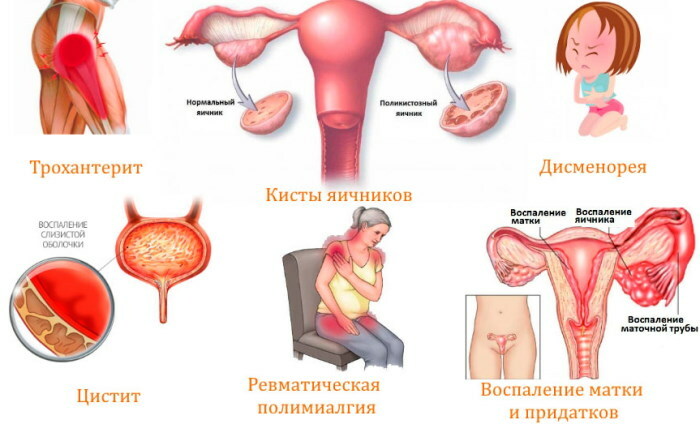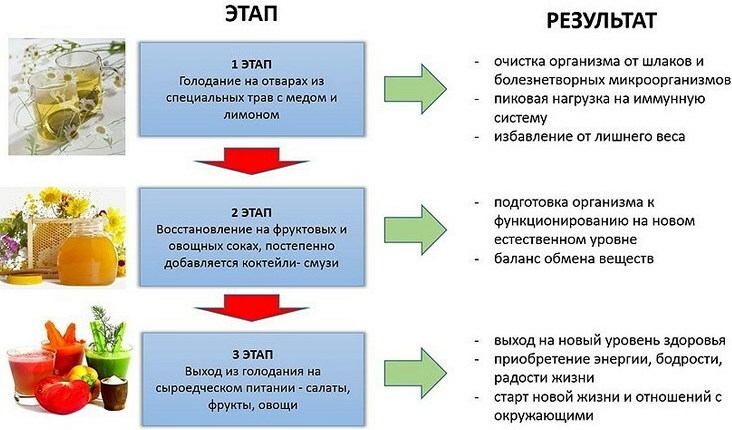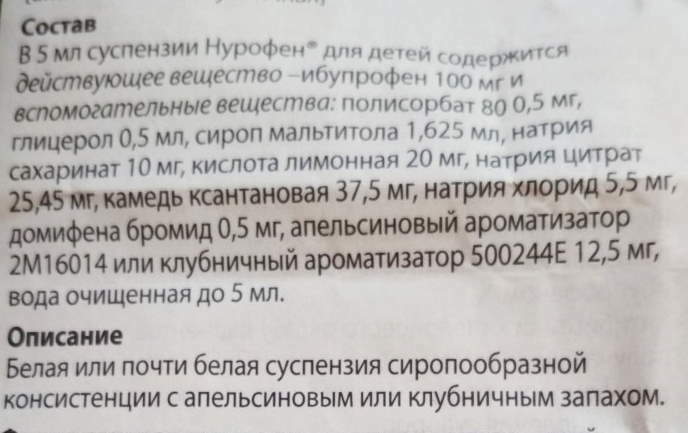Content
- What is and the reasons for the development of gout on the legs
- Diseases provoking the development of the disease
- Seizure-provoking medications
- Obesity as a cause of the development of pathology
- Forms of the disease
- Stages of development and signs of gout on the legs
- Stage 1
- Stage 2
- Stage 3
- Stage 4
- Possible complications and consequences
- Diagnosis of the disease
- What to do with an acute gout attack
- How to treat chronic illness
- Drugs regulating the level of MC in the blood
- Decongestants and pain relievers
- Herbal treatment
- Alcohol tincture of cinquefoil
- Water infusion of rose hips, juniper and watermelon seeds
- Mineral water
- Iodine
- Bile
- Diet number 6 for gout on the legs
- Operative treatment
- Gymnastics and exercise therapy
- Physiotherapy
- Recovery prognosis
- Video about gout
Gout is a chronic condition, which can affect the bones, connective and soft tissues of the legs. This pathology is accompanied by progressive inflammation of the joints, edema, and attacks of acute pain.
In most cases, gout of the lower extremities is diagnosed in men aged 30 to 60 years. If you carefully study the photo of the legs of a person with this ailment, you can find that extraneous neoplasms in the form of growths are located on the flexion areas of his joints.
What is and the reasons for the development of gout on the legs
Gout on the legs is a systemic disease that is a consequence of metabolic disorders in the patient's body. People with this diagnosis suffer from hyperuricemia.
A prolonged increase in the level of uric acid in the blood leads to the fact that the human body cannot cope with its excretion. This causes the accumulation of crystals of this substance in the form of the chemical compound sodium monourate.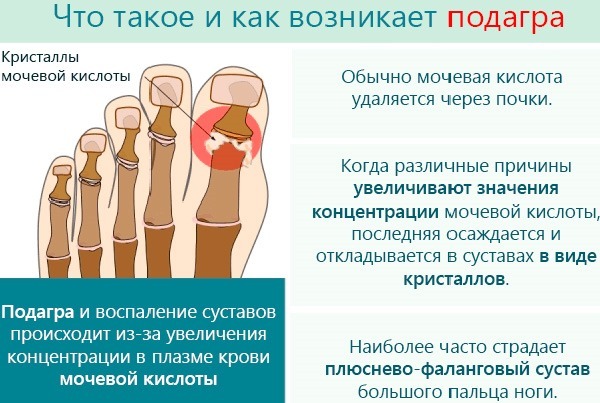
Particles of uric acid accumulate in the joints of the lower extremities, are deposited in muscle tissues, and provoke chronic or acute inflammation. The photographs show that the feet of people with severe gout always have swollen and deformed toes. There are a large number of external and internal factors that contribute to the accumulation of uric acid in the tissues of the lower extremities.
Diseases provoking the development of the disease
There are the following types of diseases, the presence of which increases the likelihood of the early development of gout:
- psoriasis;
- coronary heart disease;
- unstable blood pressure with hypertension;
- chronic renal failure;
- autoimmune disorders;
- metabolic syndrome.
In medical practice, there are occasional cases when gout of the lower extremities develops in people who have undergone internal organ transplantation. X-ray diagnostics with the introduction of a contrast agent also increases the likelihood of metabolic disorders with an increase in the concentration of uric acid.
Seizure-provoking medications
Gout of the feet is diagnosed in people who take diuretics on a regular basis thiazide group, cyclosporin antibiotics, acetylsalicylic acid at a dosage of 2 g day.
Obesity as a cause of the development of pathology
Overweight people are more likely than others to experience gout, as well as complications of this disease. In this case, the accumulation of uric acid in the joints and muscle tissues of the legs is associated with improper diet.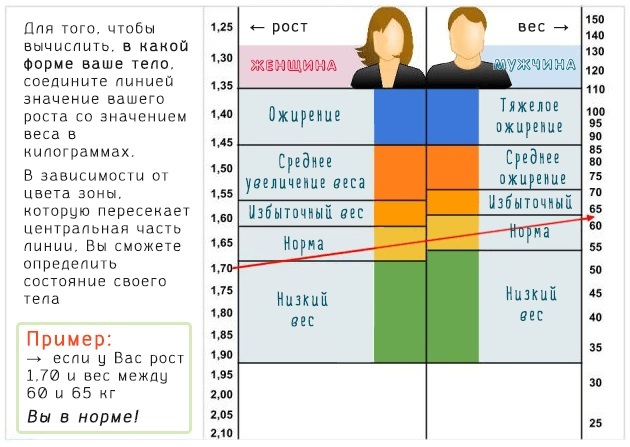
Abuse of the following foods and drinks causes morbid obesity and also contributes to the development of gout:
- fat meat;
- sweet carbonated drinks;
- chocolate;
- confectionery;
- mushrooms;
- all types of legumes;
- boiled or fried chicken eggs;
- alcohol;
- sea and ocean fish, rich in fats.
Restoring normal body weight significantly reduces the risk of developing gout, as well as a number of concomitant diseases associated with metabolic disorders.
Forms of the disease
Gout on the legs (a photo of this disease displays its particular danger to the joints) has specific causes of occurrence, or it develops under the influence of factors of unfavorable heredity. The table below describes the classification forms of this disease.
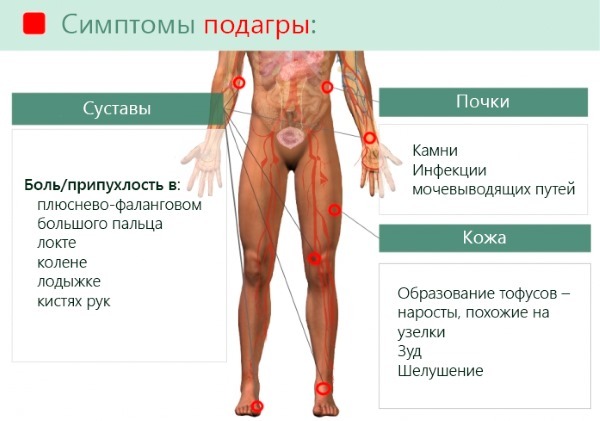
| Forms of gout of the feet | Characteristics of the pathological process |
| Primary | The development of primary gout is diagnosed in 99% of all patients who seek medical help with signs of an excess of uric acid in the joints and muscles of the legs. Even after a comprehensive examination of a patient using laboratory and hardware diagnostic methods, doctors cannot establish the true cause of the metabolic disorder. It is believed that primary gout is the result of the simultaneous influence of dietary, hereditary and hormonal factors. |
| Secondary | The occurrence of secondary gout occurs in men and women who are undergoing long-term drug therapy, and are faced with other factors that cause metabolic disorders. |
For the successful treatment of gout of the lower extremities, it is very important to timely detect the causes of this pathology, as well as take measures to eliminate them. Otherwise, rapid destruction of the joints of the legs with the progression of the inflammatory process is possible.
Stages of development and signs of gout on the legs
The classic version of the development of gout provides for the evolutionary passage of 4 stages of this disease.
Stage 1
The initial stage of leg gout has no pronounced symptoms. At this stage, the patient has no external changes in the joints and soft tissues of the lower extremities. A laboratory study of urine and venous blood shows that the patient has many times higher levels of uric acid.
Stage 2
At the 2nd stage of gout, the first symptoms of this pathology appear. The patient is periodically diagnosed with acute attacks of gouty arthritis, which are accompanied by a feeling of unbearable pain in the area of urate deposition.
Stage 3
For stage 3 of gout of the legs, the onset of the intercritical period is characteristic. At this stage, the patient feels a temporary improvement in overall health. Gout gradually becomes chronic, manifesting itself in periodic exacerbations. The accumulation of uric acid crystals continues in bone, connective tissue and muscle fibers.
At this stage, the patient feels a temporary improvement in overall health. Gout gradually becomes chronic, manifesting itself in periodic exacerbations. The accumulation of uric acid crystals continues in bone, connective tissue and muscle fibers.
Stage 4
The final stage of gout of the lower extremities is characterized by the maximum concentration of urate in the patient's body. During a visual examination of the patient's legs, multiple joint deformities are noted, which are caused by gouty complications and an acute form of arthritis.
Gout of the lower extremities is manifested by the following general symptoms:
- the metatarsophalangeal joint is affected by arthritis;
- at the time of walking, pain in the legs increases;
- on the surface of the damaged joint there is an extraneous neoplasm in the form of a growth;
- chills and fever present;
- the patient is unable to endure the acute pain that occurs at the moment of touching the surface of the joint;
- gait is disturbed;
- a higher body temperature remains in the area of the affected joint;
- the lower extremities are characterized by increased edema, and acute pain is present in the tissues with the maximum concentration of urates.
Laboratory analyzes of the patient's venous blood show that it contains at least 548 μmol / l of uric acid. In the absence of adequate therapy measures aimed at cleansing the body of urates, further aggravation of the above symptoms is possible.
Possible complications and consequences
Gout on the legs (a photo of the lower extremities of patients displays deformation changes in the structure of their joints) can lead to the development of the following complications and negative health effects:
- kidney inflammation;

- chronic arthritis;
- deterioration of blood flow through the main vessels;
- cerebral stroke;
- chronic renal failure;
- myocardial infarction;
- general intoxication of the body.
The critical concentration of uric acid in the tissues of the lower extremities and the patient's systemic blood flow can lead to severe disturbances in the work of vital organs. In such a situation, the onset of a lethal outcome is not excluded.
Diagnosis of the disease
To make the final diagnosis in the form of gout of the lower extremities, the following examination methods are used:
- visual examination of the diseased area of the body;
- palpation of the joints of the legs;
- questioning the patient to determine the nature and severity of pathological symptoms;
- biochemical blood test for the level of uric acid;
- the release of urate crystals in the synovial fluid of the inflamed joint.
X-ray is not a prerequisite for the diagnosis of gout, but nevertheless, this method of examination is able to show local deposits of urate in the structure of the diseased joint of the legs. The use of this diagnostic method allows you to control the course of chronic arthritis during its drug treatment.
What to do with an acute gout attack
Gout on the legs (a photo of the joints of the lower extremities shows the level of their swelling) is accompanied by periodic occurrence of acute attacks.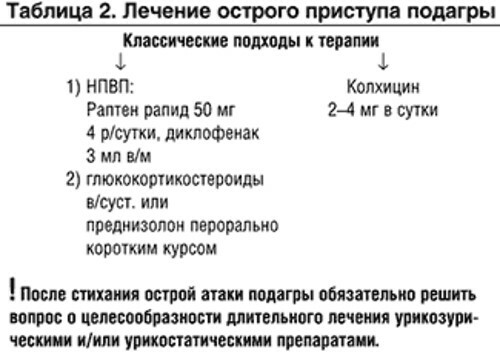
To relieve pain, non-steroidal anti-inflammatory drugs of the following types are used:
- Diclofenac;
- Bystrumgel;
- Ketoprofen Vramed;
- Voltaren.
In combination with non-steroidal anti-inflammatory drugs, the drug Colchicine is used. The dosage regimen with these medicines is determined by the doctor, depending on the severity and stage of the disease. In especially severe cases, the patient is hospitalized in a hospital of a medical institution, where he is removed synovial fluid from the inflamed joint followed by intra-articular administration of prolonged steroids actions.
How to treat chronic illness
The chronic form of gout of the legs requires complex treatment with the use of drugs, physiotherapy techniques and strict adherence to dietary norms.
Drugs regulating the level of MC in the blood
The following medications are used to contain the further progression of gout in the legs: which control the level of uric acid in the blood:
- Allopurinol - taken at a dosage of 100 to 900 mg per day after meals (96-161 rubles. for 30 tablets);
- Miluritis - is prescribed for a course reception of 1-3 tablets (dose 300 mg) per day (95 rubles. for 50 tablets);
- Remid - indicated for use in doses of 200-300 mg per day (within 88 rubles);
- Purinol - taken in a dosage of 100 to 900 mg per day, depending on the severity of gout (99 rubles. for 50 tablets of 100 mg).
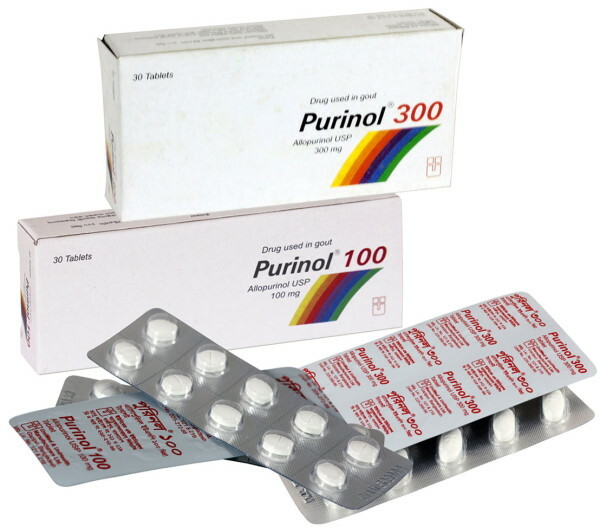
Purinol is a complete analogue and substitute for Allopurinol
Supportive therapy with drugs to regulate the level of uric acid is carried out continuously throughout the continuous treatment course. The timing of taking these medications is determined by the doctor based on the results of laboratory blood tests.
Decongestants and pain relievers
Non-steroidal anti-inflammatory drugs, which were listed in the section above, are used as pain relievers.
To eliminate signs of excessive swelling of the legs, the following medications are used:
- Veroshpiron;
- Spironolactone;
- Torasemide;
- Eplerenone;
- Uregit.
The above decongestants allow you to get rid of swelling of the legs, but at the same time cause a deficiency of magnesium, potassium and sodium salts. This leads to dysfunctional disorders in the functioning of the kidneys, causing an imbalance of blood electrolytes.
Herbal treatment
Gout on the legs (a photo of this disease shows complications that can occur without timely therapy) is treated with infusions and decoctions based on medicinal plants.
Alcohol tincture of cinquefoil
To prepare this product, the following recipe must be observed:
- Take 100 g of rhizomes and stems of cinquefoil.
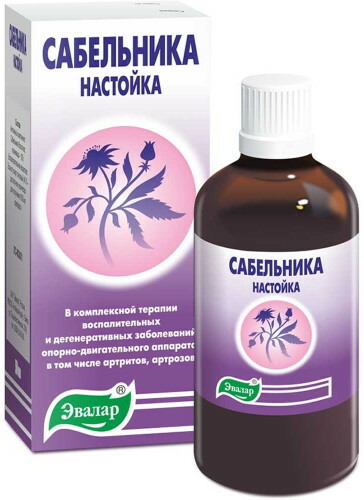
- Pour 0.5 l of vodka over vegetable raw materials.
- Place the container with the future medicine for 2 weeks in a dark place for infusion.
After a specified period of time, the tincture is filtered through cheesecloth, and then 30 drops are taken from 3 to 4 times a day before meals. The terms of treatment are from 3 to 4 months.
Water infusion of rose hips, juniper and watermelon seeds
The preparation of this folk remedy is as follows:
- It is necessary to take 2 tbsp. l. watermelon seeds, juniper and rose hips.
- These ingredients are ground in a coffee grinder to a powder.
- The resulting mass is poured into 1 liter of boiling water, and then left for 20 minutes. for insisting.
This remedy is taken in 1/4 of a glass in the morning and at lunchtime before meals. The average duration of a therapeutic course is 2 months.
Mineral water
Alkaline mineral water is used to normalize the indicators of uric acid in the blood, as well as to relieve complications associated with urate deposition. This agent is taken orally in 100-250 ml daily for 15 minutes. before the meal. Alkaline compounds contained in mineral water neutralize uric acid. In Russia, one of the best remedies for the treatment of gout is the Maykopskaya mineral water, which costs 15 rubles. for 500 ml.
Iodine
To treat gout on the legs, an alcohol solution of iodine is used, which is combined with baking soda.
The recipe for this product is as follows:
- Boil 3 liters of water, and then set aside the container with liquid to cool down to a temperature of 40 degrees.
- Add 9 drops of Iodine alcohol solution to the water.
- Stir 30 g of baking soda into the water-alcohol liquid.
The prepared solution is poured into a basin, into which for 10 minutes. fit the legs affected by gout. With the help of this tool, the diseased joints are heated, and the chemicals in this solution contribute to the breakdown of urates. After 10 minutes. the patient should wipe his feet dry, lubricate the joints with petroleum jelly or natural olive oil, and then put on warm socks. The therapeutic procedure is performed daily at bedtime.
Bile
Gout on the legs (a photo of the disease confirms the fact of deformational changes in the structure of the joints) is treated with Medical Bile.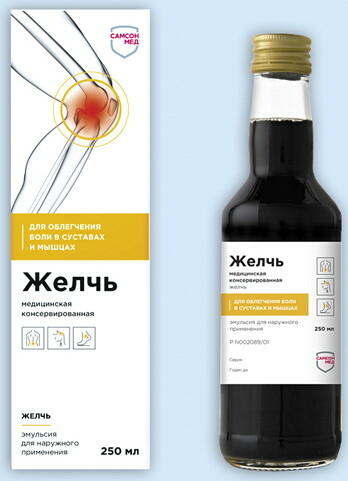
The use of this drug requires adherence to the following rules:
- Take a sterile gauze bandage.
- Apply a small amount of bile to this piece of tissue.
- Fasten a gauze bandage soaked in medication on the surface of the diseased joint of the leg.
- Wrap the lower limb with an elastic bandage so that the piece of fabric is in close contact with the skin.
Re-replacement of the gauze bandage with its impregnation with Medical bile is carried out at the same time 1 time per day. The use of this method is contraindicated in the presence of open wounds or suppuration. The average duration of a therapeutic course is 1 month.
Diet number 6 for gout on the legs
Diet table number 6 was developed by the doctor Mikhail Pevzner.
People with gout are allowed to eat the following foods and drinks:
- rye and wheat bread;
- borscht and lean vegetable soups;
- boiled chicken (no more than 150 g per week);
- hard cheese;
- milk;
- sour cream;
- kefir;
- fermented baked milk;
- curdled milk;
- boiled chicken egg (no more than 1 pc. in a day);
- vegetable salads;
- boiled potatoes;
- the vinaigrette;
- fresh and dried fruits;
- compotes.

Patients with signs of gout of the legs are strictly prohibited from using the following foods and drinks:
- beer;
- tea;
- coffee;
- wine;
- strong alcohol;
- fatty meats and fish;
- sweet carbonated drinks;
- rich pastries;
- pork fat.
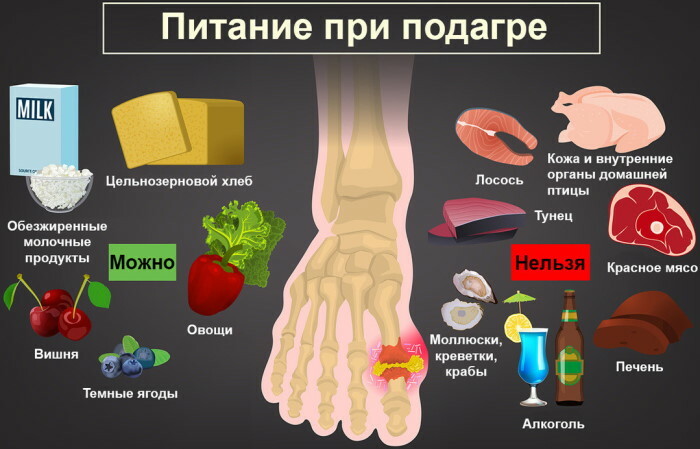
It is recommended to refrain from foods that contain high acid levels. Diet table No. 6 according to Pevzner should be supplemented daily with 1 glass of alkaline mineral water. This will prevent further progression of the disease, as well as accelerate the process of excretion of urates outside the body.
Operative treatment
Surgical operation is indicated for patients diagnosed with volumetric salt deposits in the area of the joints of the lower extremities.
Surgical treatment of this pathology is performed according to the following algorithm of actions:
- The surgeon injects the patient with a drug for local tissue anesthesia.
- A skin incision is made in the area of the inflamed joint.
- With the help of surgical instruments, the accumulation of urates, provoking the pathological process, is removed.
- The doctor sutures the tissues of the patient's leg, injured during the operation.
Surgical treatment of gout is most effective in those clinical situations when the inflammatory process has not yet led to a severe form of arthritis and deformational changes in the structure of the composition.
Gymnastics and exercise therapy
To prevent complications from gout, the following exercise therapy exercises are recommended:
- while in a sitting position, straighten the leg at the knee, pulling it forward;
- squat 15-20 times daily without using additional sports equipment;
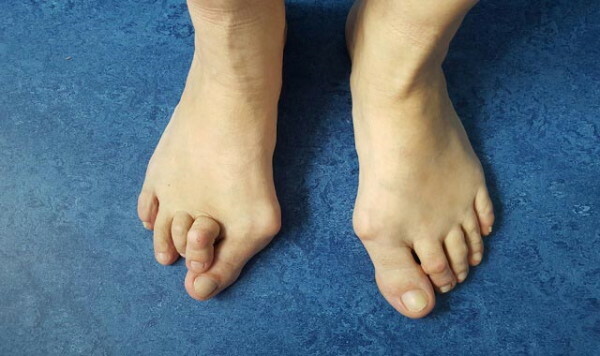
Gout on the feet - sitting on a chair, tear your feet off the floor, and then alternately bend and unbend the toes of the lower extremities;
- lift up the right and left leg from a supine position;
- descend and rise on the toes of the lower extremities, so that a comprehensive training of the ankle joint is carried out.
During the period of the next exacerbation of gout, it is recommended to temporarily refrain from performing physical exercises for the joints of the lower extremities. During acute inflammation of the tissues of the legs, an increase in pain is possible.
Physiotherapy
The table below lists the main physiotherapy techniques that can help prevent further progression of gout in the legs.
| Physiotherapy methods | Description of the treatment process |
| Electroneurostimulation | This physiotherapy method is aimed at stimulating the peripheral nerves located near the diseased joint of the lower limb. The electrodes of the electroneurostimulation apparatus are placed on top of the skin covering the joint. Synchronous electrical impulses improve local blood circulation, promote the synthesis of more endorphins, and reduce pain. The average duration of tissue electroneurostimulation is 10-15 minutes. |
| Massotherapy | With the help of slow massage movements, the areas of the diseased joint, which have signs of mineral deposits, are kneaded. The physiotherapy procedure is performed independently or by a healthcare professional. The average duration of 1 session of therapeutic massage is 15-20 minutes. daily. |
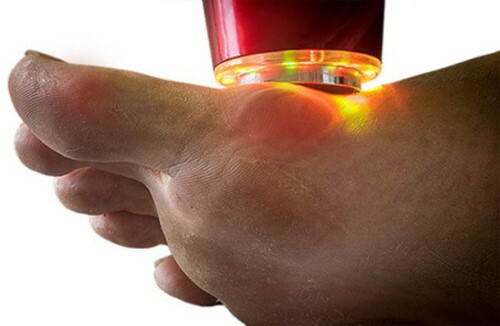 It is believed that the maximum benefit from the use of physiotherapy techniques is achieved when they are used in conjunction with taking medications. Especially with the simultaneous treatment with non-steroidal anti-inflammatory drugs and medicines that regulate the level of uric acid in the blood.
It is believed that the maximum benefit from the use of physiotherapy techniques is achieved when they are used in conjunction with taking medications. Especially with the simultaneous treatment with non-steroidal anti-inflammatory drugs and medicines that regulate the level of uric acid in the blood.
Recovery prognosis
Gout is a chronic disorder of uric acid metabolism. It is impossible to achieve complete recovery, but with the help of drugs to reduce the level of MK in the blood, observing dietary norms, it is quite possible to achieve a stable remission with a minimum risk of developing acute gouty attack.
Patients with this disease are constantly monitored by a rheumatologist or nephrologist. In the absence of concomitant complications from the kidneys, the prognosis for maintaining a stable functioning of the body is favorable. Abuse of meat, fish dishes, regular drinking of alcoholic beverages will lead to a progressive deterioration in general health, the development of acute arthritis of the joints and kidney failure.
Gout on the legs manifests itself gradually as urate accumulates in the bone, connective and muscle tissue. At the initial stage of the development of the disease, a person does not feel pathological symptoms, but the results of a biochemical blood test show that the level of uric acid is exceeded in his body.
As metabolic disorders progress, the mechanism of urate deposition in the structure of the leg joints is triggered. These areas of the lower extremities acquire signs of swelling, the color tone of the skin changes, and attacks of acute rheumatic pain join. A photo of the feet of people who have gout confirms the danger of this disease, and also displays the risk of complications.
Video about gout
Causes, symptoms, treatment of gout:

